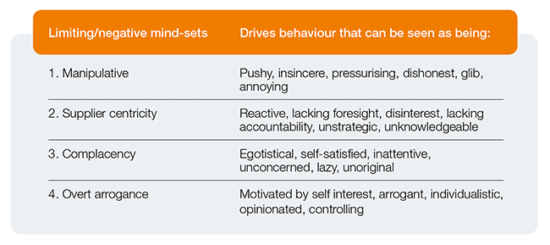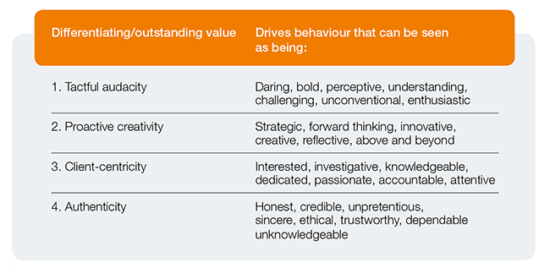The importance of values
23rd April 2017 | Dr Philip Squire
In an original project submitted for his Doctor of Professional Studies qualification, Phil Squire asked: How can a “client-centric values” approach to selling lead to the “co-creation” of a new global selling mind-set? Here’s what he found out.
In 2002, I conducted an interview with the Chief Information Officer of IMS Health, a large, global, pharmaceutical company. The subject of the interview was “How do you want to be sold to?’
The interview was videoed and structured around three topics – I wanted to understand the challenges a CIO faced when operating within a global company; given these challenges, what qualities he looked for in a salesperson; and finally, what expectations he had of salespeople. I asked him to provide me with examples of what salespeople did that he liked and disliked. It was a productive interview but, like many interviews that are conducted under the video camera, it is when the interview is over that the interviewee relaxes and opens up.
Clearly, he felt strongly about what he was saying, so I asked him, almost as he was leaving my office: “What percentage of salespeople met his expectations?” To which he answered: “90% of salespeople are, in my view, a complete waste of time.”
I decided to continue this line of questioning with the next two interviews, the first of which was with the chief technology officer of one of world’s largest mobile phone operators. After his interview, he said that, in his view, only 10% of salespeople “get it”. Two out of these three initial interviewees were very critical of the performance of salespeople.
So striking were these comments, that I started an enquiry process to find out the extent to which salespeople were failing in their attempts to make the right impression and the reasons for this.
Emergence of a burning platform
By the end of 2003, I had interviewed a further ten of our customers. Of these, eight said either that they had a low opinion of salespeople, or that less than 10% of salespeople met their expectations. Whilst this sample was still small, those I had interviewed were senior-level executives from a range of different industries, including banks, telecoms, retail, and pharmaceutical. Between them, these executives had significant experience in dealing with salespeople. The pattern of feedback was consistent with the first three interviews conducted. I had not only established that most salespeople were underperforming, but I had data that helped to identify what customers were looking for from salespeople.
Questioning the competency framework
I had a nagging question that, somewhere, I had missed some important clues as to the reasons for poor sales performance. Sales training consulting companies, like mine, had, for years, developed programmes on leadership, listening, financial value selling, running virtual sales teams, and so on. Companies had also invested in complex customer relationship management systems with a view to improving their sales process. Remuneration systems were there to incentivise good sales performance. Why, then, were salespeople still held in such low esteem by customers?
By 2006, there was enough evidence to suggest that there was “a burning platform” – that addressing the problem with a competency mind-set had not worked, and nor had investments made by companies in other sales performance enablers, such as CRM. I began to question my deeply held assumption that performance was linked to competency.
I attended a presentation by Jean McNiff in August 2006. She started the presentation by saying that “to get a clear idea of what action research is, is to be clear about your ‘values’”. This prompted a deep enquiry into my own values, and enabled me to reflect on all the interview transcripts through a different lens. Rather than looking at customer interviews with a competency-based mind-set, I should explore the interview transcripts with a values-based mind-set.
My logic was as follows: customers are critical of many of the behaviours they see in salespeople, and they also describe how they want salespeople to sell to them. Behaviours of salespeople are influenced by competencies as well as values. Having the right values would influence the right behaviours.
For example, a salesperson who truly held a value that was customer-focused would be naturally inclined to listen carefully to what a customer was saying, would not manipulate the conversation, would ask the right questions, etc. Furthermore, I sensed that, if the values were engrained, ie lived, competencies would evolve naturally.
Could it be that companies had never seriously considered the role of values in the sales process? Could the disconnect be a values misalignment rather than a competency misalignment? To what extent were companies seeking to align their values framework with those of their customers?
Thus began an enquiry to establish the importance of values in the sales process. Dependent on the results, could a new framework emerge that would enable practitioners to develop closer, deeper, and more profitable relationships with their key customers?
Results
From 2002 through to 2008, 88 interviews were conducted with customers and key account sales executives – of these, 66 were customer interviews: 73% either had a low opinion of salespeople or said that less than 10% of salespeople met their expectations. This represents a “burning bridge”. These statistics are also endorsed by fellow consultants and authors (Hanan, 1999, Legat & Woehr, 2002, Bosworth & Holland, 2004, and Fielder, 2002), each of whom has formed the opinion that only a small percentage of people exceed customer expectations.
My research has shown that, when making purchasing decisions, customers seek a layer of value that goes beyond the product or solution. Customers look for a complex amalgam of attributes from their account executive: the ability to sustain intelligent conversation (as one interviewee stressed, “Don’t give me data, give me intelligence!”); leadership to leverage resources from disparate parts of their organisations, (“I want a salesperson; I just don’t want him pointing at me; I want him pointing back inside his organisation; I want him to leverage my weight and power back inside his company in order that I can get a better deal all round.”); collaboration to work with resources from both inside and outside the companies that both parties represent; underpinned by authenticity (“We would like to work with honest people.”). The baseline point of entry for salespeople to be effective in selling complex solutions has changed – but to what?
I observed that customers look beyond the spoken word to obtain a perspective of a person’s values. I have found that there are serious misalignments between the values customers seek in salespeople and what they experience.

Table 1: Limiting/negative values.
Four negative values
I conclude that negative behaviours are linked to four ‘Limiting/negative’ values (Table 1) I use the term “limiting” as these values may not necessarily lose a sale, though they could. If a salesperson is trained to live these limiting values, or does so through their personality, they will not meet customer expectations and will under-perform.
It is important to remind ourselves that the table lists values that the buyers see reflected in the behaviours and attitudes of salespeople – not necessarily values to which salespeople aspire. Arrogance is sometimes seen in salespeople who represent large world-class companies – we are big, therefore the best. As one customer interviewee said, “Don’t give me this bullshit about yours being the best product or best of breed because no one has the best product. It depends on what the business requires.” I suspect that, in many instances, arrogance is sometimes confused with confidence, and is an expected attribute of salespeople, and that these qualities are actively sought when recruiting.
In the same way as we defined the four limiting/negative values, we identified four positive values, ie those values that customers seek of salespeople (Table 2).
Over time, I came to conclude that, of these, proactive creativity and tactful audacity are the two differentiating and outstanding values, meaning they are most important for customers and most lacking in salespeople. However, these values have to be balanced by client-centricity (for relevance) and authenticity (for trust). They can be regarded as sales disciplines, mastery of which is achieved through practice and constant reflection. “Am I doing the right things for my customers?”, “What creative ideas can I bring?”, “How can I validate these ideas?”, and, by doing so, “Am I doing the right thing for my company?”
Trust
A salesperson has to earn the right to live the values of tactful audacity and proactive creativity. Unless a customer feels that the salesperson is someone in whom they can trust, they will view proactive creativity with suspicion, and tactful audacity as arrogance. The baseline point of entry, therefore, is being authentic and demonstrating behaviour that is client-centric.
The research shows that, all too often, salespeople are seen to be living the limiting and negative values – this leads to different levels of distrust. One of my customers said that “trust” is not the same as “loyalty”, implying that it is possible for a customer to show loyalty through repeat purchases but that this does not mean the customer trusts you.
It is clear that whilst customers want to be challenged (tactful audacity) and want suppliers to be proactive (proactive innovation), they only allow suppliers to engage fully at this level when trust has reached a certain level, at which point they divulge insights about problems they want to be solved or opportunities gained. A global account manager recently endorsed this perspective.
He used the term “customer-driven innovation” to describe a project that his customer asked him to engage with. It was clear that the customer could have invited any number of suppliers to consider this particular project. He entrusted this particular vendor with information that was not divulged to others. The global account manager was able to use this information to drive through an innovation that had never before been attempted in his industry. As a result of a trusted relationship, he was able to live the values of proactive innovation, thereby reinforcing the value of the supplier to the customer. which, in turn, would strengthen the trust between both parties.
A 24-month project working with Hewlett Packard’s EMEA outsourcing team, where a total of $4.2 billion dollars has been closed on deals where the values-based approach was applied, endorses this new values-based approach. All of the deals closed were with global customers. At a 70% conversion rate, we found there is a more than a triple chance of winning deals using this approach when compared with deals that did not use the approach.

Table 2: Positive values.
Barriers to Implementing the values-based approach
We learnt that the journey is not easy. Breaking the cultural mind-set from within was as difficult as changing the cultural mind-set from without. In situations where customers see these deals as purely transactional, and where procurement departments are trying to have all vendors compete at the same level so they can compare “apples with apples”, salespeople have to be particularly compelling, creative and audacious to change the transactional mind-set to a values-based mind-set.
I suspect the same values we have developed externally to customers also apply internally to the suppliers, as salespeople seek to leverage across the different “silos” of an organisation where the same resistance can be found. When discussing our research findings with global account executives, it is clear that those companies’ sales processes and remuneration systems often encourage “limiting values”.
Short-term bonus payments encourage short-term vision and individualistic and ego-centric behaviour, and silo mentality makes it very difficult for salespeople to leverage across their companies and perhaps leads to complacency – the effort of trying to orchestrate the resources of their company is simply too much.

Figure 1: Attributes required for global/complex sales effectiveness
Findings
My findings show that, whilst many companies establish corporate values, their approach to values stems from an inside out perspective, (Barrett, 2006, Cameron, 2006). In contrast, our suggestion is that, by taking a client-centric approach to setting policy on values – an outside in perspective – companies would forge closer and more lucrative and strategic relationships with their customers.
Our research suggests that companies will achieve greater sales performance by having to look beyond traditional techniques, skills and processes. These are simply the tools that reflect the DNA of behaviour – values. The right behaviours will only come about in an “authentic” way if they are hard-wired into a sales organisation’s “belief” system, ie if you believe in something strongly enough, you will devote time to it and do it.
I conclude that a strong client-centric value system is required to support the development of the sales organisation (Figure 1). (None of the companies we have interviewed has developed such a value system.) My opinion is that support infrastructure, methods and processes, attributes and behaviours are required to be aligned to the value system. The job of management is to remove the “constraints” that often result in limiting values. By living the differentiating values, the sales force will be a top 10% performer.
Global implications
Our empirical research and action research crossed many national borders; our construct of values therefore was influenced by interviewees and customers from different cultural backgrounds. Our model suggests that living the four values helps develop sales performance across all boundaries and, therefore, can be a global model. Our research suggests how customers perceive behaviours, and how behaviours inform customers as to the values of salespeople.
We recognise that at a behavioural level there are cultural differences (Hofsteade et al, 2002). How one lives the four positive values will be different from country to country. Developing trust in Japan as a Japanese person will be different to developing trust in the United Kingdom. To create a global model suggesting the types of behaviours required to live the values could be helpful in suggesting how sales organisations approach training and development across different countries.
Key conclusions of this research
Having explored the extent to which a values-based approach to developing relationships between salespeople and their customers enhances sales performance, we can conclude that “traditional” approaches to selling have outlived their usefulness – whilst they purport to be based on models that are customer-centric, they are based on perspectives of sellers and are not, therefore, aligned to the needs of customers.
Empirical research with 83 customers and key account managers provides the basis for an emerging values construct based on four differentiating values for outstanding sales performance – tactful audacity, proactive creativity, client-centricity and authenticity – plus four negative values that produce poor performance: ego-centricity, manipulation, complacency, short-sightedness.



